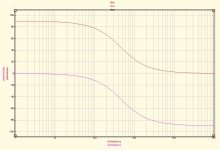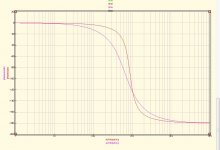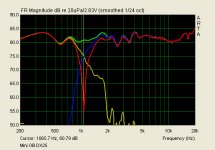Hi to all, I have a question that someone maybe can answer. In a multiway system 2way or 3 way the goal is to make the driver to run in phase or not? I am asking because in a 2way speaker of mine I used a first a first order filter for LF and a first order for the tweeter, and after that a second order for both with the tweeter inverted. I ploted the phase diagrams and I found that in the second situation the drivers are exactly in phase, while in the first situation the tweeter is leading by 90 degrees. The starnge to me is that the first is more pleasant. Can someone comment anything on that? I also uploded the plots.
Attachments
Here's an article that covers your questions...
Phase, Time and Distortion in Loudspeakers
Phase, Time and Distortion in Loudspeakers
Hi,
Drivers in phase mean at crossover frequency, the SPL of each drivers sum themselves perfectly . To verify the good phase you should invert one driver and measure the deep of the SPL. If the SPL curve has an enough deep hole >30dB, it is near perfect. Without actuals measurements you can't say anything.
For example, here a 12" + 1" 1.1kHz ~LR4
For me the order of the electrical crossover don't have a lot of sense. You should use acoustic curves to do something. If you use a first electrical order crossover, you should have second order acoustic response. If you use a second order electrical, you should have fourth order acoustic etc.
I can't say anything else because I don't know the drivers, the expected crossover frequency.

Yes it is one very important part of the designIn a multiway system 2way or 3 way the goal is to make the driver to run in phase or not?
Drivers in phase mean at crossover frequency, the SPL of each drivers sum themselves perfectly . To verify the good phase you should invert one driver and measure the deep of the SPL. If the SPL curve has an enough deep hole >30dB, it is near perfect. Without actuals measurements you can't say anything.
For example, here a 12" + 1" 1.1kHz ~LR4
An externally hosted image should be here but it was not working when we last tested it.
For me the order of the electrical crossover don't have a lot of sense. You should use acoustic curves to do something. If you use a first electrical order crossover, you should have second order acoustic response. If you use a second order electrical, you should have fourth order acoustic etc.
I can't say anything else because I don't know the drivers, the expected crossover frequency.
Thanks for the respone to all of you. Jerome can you upload the img to diyaudio directly because somehow I can not see images from imageshack. Jerome you say that this is the goal to have drivers in phase, what I found out is that when drivers are in phase in my situation they sound everyehere and in any hight the same but not so alive as when is driven with 1st order. The drives are beyma tp21 tweeter and a celestion 15 inch woofer truvox 1525. Which one to prefer. Thnks
Can someone comment anything on that? I also uploded the plots.
Your phase curves appear to be the phase of the filters alone. When combining filters and drivers to make a system the relevant phase elements would be from the filter, from the general phase curve of the drivers (each is a bandpass with phase lag on the top end and phase lead on the bottom end) and finally from the inherent delay of one unit vs. the other. Most of the time a woofer is deeper than a tweeter and has significant time delay or phase lag because of it.
When all of those elements are combined for the woofer and also for the tweeter, then the relative phase in the crossover region determines whether the units add well and with which phase polarity they best combine. Jerome's graph shows that very well. You don't see the phase curves but you can surmise that the polarities of the green curve are giving a very good sum (good relative phase in the crossover region) while the red curve shows heavy cancellation due to reversing one of the driver's connections.
Note that that set of curves would be true for a position in space and when you move nearer one driver and away from the other, the story changes. This leads to nulls in the polar curve at the crossover frequency.
David
- Status
- This old topic is closed. If you want to reopen this topic, contact a moderator using the "Report Post" button.


